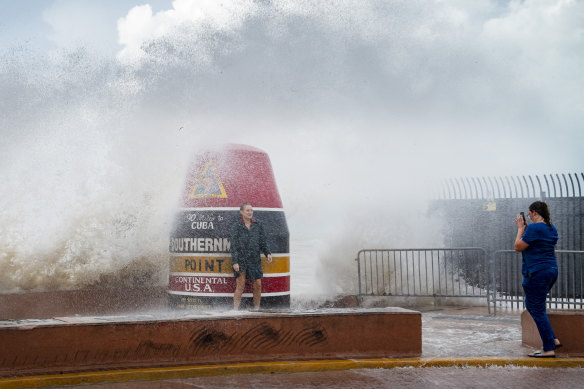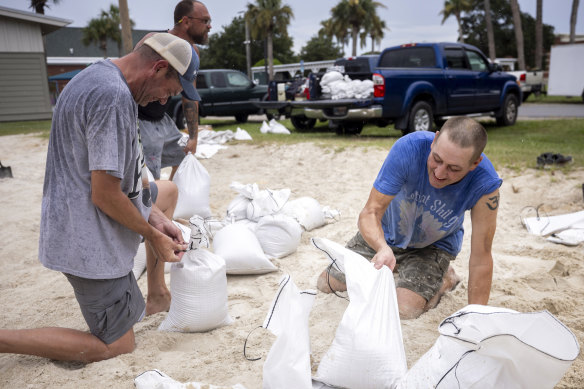This was published 1 year ago
‘An unprecedented event’: Hurricane Idalia hits Florida’s west coast bringing strong winds, flooding
By Daniel Kozin
Cedar Key, Florida: Hurricane Idalia has made landfall on Florida’s west coast as a dangerous Category three storm on Wednesday unleashing potentially life-threatening storm surges and rainfall.
More than 200,000 customers were without electricity as trees snapped by strong winds brought down power lines and water submerged streets.
Along the coast, some homes were submerged to near their rooftops, and structures along the ocean crumpled in the surge. As the eye moved inland, destructive winds shredded signs and rooftops.
“We have multiple trees down, debris in the roads, do not come,” posted the fire and rescue department in Cedar Key, which was taking some of the biggest storm surge. The department’s post said most of the streets around the downtown area were underwater.
Florida residents living in vulnerable coastal areas had been ordered to pack up and leave as Idalia gained strength in the warm waters of the Gulf of Mexico. And those who didn’t were warned to find a safe place while the storm moves through.
“Don’t put your life at risk by doing anything dumb at this point,” Governor Ron DeSantis said at a news conference on Wednesday morning. “This thing’s powerful. If you’re inside, just hunker down until it gets past you.”
It made landfall with maximum sustained winds near 205km/h, bringing flooding to the streets of Tampa and other communities. Storm surge could rise as high as 4.5 metres in some places.
Idalia came ashore in the lightly populated Big Bend region, where the Florida Panhandle curves into the peninsula. The result could be a big blow to a state still dealing with lingering damage from last year’s Hurricane Ian.
The National Weather Service in Tallahassee called Idalia “an unprecedented event” since no major hurricanes on record have ever passed through the bay abutting the Big Bend.
Hurricanes are measured on a five category scale, with a Category five being the strongest. A Category three storm is the first on the scale considered a major hurricane.
It had been projected to make landfall early on Wednesday as a Category 4 storm with winds of at least 209 km/h.
On the island of Cedar Key, Commissioner Sue Colson joined other city officials in packing up documents and electronics at City Hall. She had a message for the almost 900 residents who were under mandatory orders to evacuate.
“One word: leave,” Colson said. “It’s not something to discuss.”

Visitors to the Southernmost Point buoy brave the waves made stronger from Hurricane Idalia.Credit: AP
Not everyone was heeding the warnings to leave. Andy Bair, owner of the Island Hotel, said he intended to “babysit” his bed-and-breakfast, which predates the American Civil War. The building has not flooded in the almost 20 years he has owned it, not even when Hurricane Hermine flooded the city in 2016.

Trenton Spencer (right) fills sandbags for his neighbours in preparation for Hurricane Idalia.Credit: AP
“Being a caretaker of the oldest building in Cedar Key, I just feel kind of like I need to be here,” Bair said. “We’ve proven time and again that we’re not going to wash away. We may be a little uncomfortable for a couple of days, but we’ll be OK eventually.”
Tolls were waived on highways out of the danger area, shelters were open and hotels prepared to take in evacuees.
More than 30,000 utility workers were gathering to make repairs as quickly as possible in the hurricane’s wake. About 5500 National Guard troops were activated.
In Tarpon Springs, a coastal community north-west of Tampa, 60 patients were evacuated from a hospital out of concern that the system could bring a 2.1-metre storm surge.
After landing in the Big Bend region, Idalia is forecast to cross the Florida peninsula and then drench southern Georgia and the Carolinas on Thursday. Both Georgia Governor Brian Kemp and South Carolina Governor Henry McMaster announced states of emergency, freeing up state resources and personnel, including hundreds of National Guard troops.
“We’ll be prepared to the best of our abilities,” said Russell Guess, who was filling his vehicle with petrol in Valdosta, Georgia. His co-workers at Cunningham Tree Service were doing the same. “There will be trees on people’s house, trees across power lines.”
Idalia pummeled Cuba with heavy rains on Monday and Tuesday, leaving the tobacco-growing province of Pinar del Rio underwater and many of its residents without power.
“The priority is to reestablish power and communications and keep an eye on the agriculture: Harvest whatever can be harvested and prepare for more rainfall,” President Miguel Díaz-Canel said in a meeting with government officials.
State media did not report any deaths or major damage.
Many school districts along the Gulf Coast were to be closed through at least Wednesday. Several colleges and universities also closed, including the University of Florida in Gainesville. Florida State University in Tallahassee said its campus would be closed through Friday.
Two of the region’s largest airports stopped commercial operations, and MacDill Air Force Base on Tampa Bay sent several aircraft to safer locations.
Asked about the hurricane, President Joe Biden said he had spoken to DeSantis and “provided him with everything that he possibly needs”.
Ian was responsible last year for almost 150 deaths. The Category 5 hurricane damaged 52,000 structures, nearly 20,000 of which were destroyed or severely damaged.
The National Oceanic and Atmospheric Administration recently said the 2023 hurricane season would be far busier than initially forecast, partly because of extremely warm ocean temperatures. The season runs through November 30, with August and September typically the peak.
AP
Get a note directly from our foreign correspondents on what’s making headlines around the world. Sign up for the weekly What in the World newsletter here.